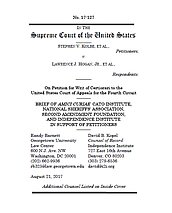Kolbe v. Hogan
Learn more about Cato’s Amicus Briefs Program.
A Maryland statute prohibits ownership of “assault weapons,” the statutory definition of which includes the most popular semi-automatic rifles — one bullet per trigger-pull without reloading — in the country, as well as magazines capable of holding more than 10 cartridges (bullets). Stephen Kolbe, a small business owner, among others, sued to overturn the law. The U.S. Court of Appeals for the Fourth Circuit upheld Maryland’s ban. The Fourth Circuit extrapolated from a shred of the landmark 2008 District of Columbia v. Heller case, suggesting that weapons “most useful in military service — M‑16 rifles and the like” could be banned. From that squib, the court decided that the test for whether or not a class of weapons could be banned was whether it was “like an M‑16.” That not only contravened the core of Heller — that all weapons in common lawful civilian use are constitutionally protected — but raised a host of other issues. Accordingly, Kolbe is now asking the Supreme Court to review his case. Cato, joined by the Second Amendment Foundation, Independence Institute, and National Sheriffs’ Association — a law enforcement organization! — has filed a brief, co-authored by Georgetown law professor Randy Barnett, supporting that petition. We point out that the Maryland law classifies the common semi-automatic firearms used by police officers as “weapons of war,” alienating officers from their communities and undermining policing by consent. Where for generations, Americans needed look no further than the belt of their local deputies for guidance in selecting a defensive firearm, Maryland’s restrictions prohibit those same arms to their citizens. Those weapons selected by law enforcement specifically for their reliability, accuracy, and overall utility as defensive weapons, would be unavailable for the lawful purpose of self-defense. Maryland considers them weapons of war, best suited for inflicting mass carnage. At a time and place where tensions between police and policed are a sensitive issue, the law sets up a framework where the people of their state could be fired upon by police with what the state restricts as “weapons of war,” a principle that only serves to drive a wedge between police and citizenry. Further, arms falling within the scope of Maryland’s ban were not only in common use at the time of the law’s enactment, but have existed since the 16th century. By the time of the Constitution’s ratification, the state of the art in shoulder arms was a 22-shot repeater. Thus, it cannot be said that repeating arms were beyond the contemplation of the Second Amendment. Moreover, by the time the Fourteenth Amendment was enacted — through which the right to keep and bear arms is enforceable in the states — repeating arms holding 11 or more cartridges were available and in common use worldwide. Today, the majority of firearms sold in the United States for self-defense are prohibited in Maryland. The Fourth Circuit erred in upholding this denial of Marylanders’ constitutionally protected arms. This law was particularly egregious in its outright banning of common semi-automatic arms — and there exist no similar laws in other jurisdictions which are longstanding or traditional. Maryland’s law is unconstitutional on its face and the Fourth Circuit’s reasoning in upholding it lacks legal or historical foundation.
